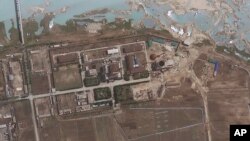A senior U.S. intelligence official and a report by a Washington-based research institute are warning of advances in North Korea's nuclear and missile programs.
Director of National Intelligence James Clapper said Pyongyang has expanded the size of its Yongbyon uranium enrichment facility and restarted a reactor used for plutonium production.
His statement Wednesday appeared to confirm recent reports suggesting North Korea is making good on its promise to "adjust and alter" its nuclear facilities following its third nuclear test last year.
In his written testimony to a Senate committee, Clapper said the North's nuclear weapons and missile programs "pose a serious threat" to the U.S. and Asia, noting that Pyongyang is committed to developing a missile that can strike the U.S. mainland.
Clapper said the North has publicly displayed its road-mobile intercontinental ballistic missiles, known as the KN-98, but stressed that the system remains untested.
Center for Strategic and International Studies (CSIS) Korea Chair Victor Cha told VOA's Korean service that Pyongyang's missile program is not the biggest issue faced by the U.S. at this time. "The biggest concern for the Obama’s administration right now is the nuclear program, and within the nuclear program, it is the so called covert uranium based program. I think is the major concern because if developed that could potentially exponentially increase the North Korea’s capacity to produce nuclear bombs," he said.
The RAND Corporation's Bruce Bennett said it is unclear how developed the North Korean technology is right now. "Well most of the North Korean rockets so far have been pretty unsophisticated. And the missiles that they have show that are smaller, that could be ICBMs, what we've seen so far, have been pretty clearly mockups. And so its not clear that they have gotten sophisticated enough to pose a serious threat to the United States, but they are moving in that direction," he stated.
In a separate report Wednesday, the U.S.-Korea Institute at Johns Hopkins University said North Korea appears to be expanding its main launch site to accommodate larger missiles that could hit the United States.
But the report, which relied on recent satellite photos, warned that because of ongoing construction the site will likely not be available for launches until March or April at the earliest.
South Korea and the United States have been watching North Korea closely for a military provocation, such as a nuclear or missile test, following the shocking execution of Kim Jong Un's uncle, who was accused of plotting to overthrow the state.
Seoul's Unification Ministry said Thursday it is "very serious and regrettable" that North Korea has made progress in its nuclear program.
This report was produced in collaboration with the VOA Korean service.
Director of National Intelligence James Clapper said Pyongyang has expanded the size of its Yongbyon uranium enrichment facility and restarted a reactor used for plutonium production.
His statement Wednesday appeared to confirm recent reports suggesting North Korea is making good on its promise to "adjust and alter" its nuclear facilities following its third nuclear test last year.
In his written testimony to a Senate committee, Clapper said the North's nuclear weapons and missile programs "pose a serious threat" to the U.S. and Asia, noting that Pyongyang is committed to developing a missile that can strike the U.S. mainland.
Clapper said the North has publicly displayed its road-mobile intercontinental ballistic missiles, known as the KN-98, but stressed that the system remains untested.
Center for Strategic and International Studies (CSIS) Korea Chair Victor Cha told VOA's Korean service that Pyongyang's missile program is not the biggest issue faced by the U.S. at this time. "The biggest concern for the Obama’s administration right now is the nuclear program, and within the nuclear program, it is the so called covert uranium based program. I think is the major concern because if developed that could potentially exponentially increase the North Korea’s capacity to produce nuclear bombs," he said.
The RAND Corporation's Bruce Bennett said it is unclear how developed the North Korean technology is right now. "Well most of the North Korean rockets so far have been pretty unsophisticated. And the missiles that they have show that are smaller, that could be ICBMs, what we've seen so far, have been pretty clearly mockups. And so its not clear that they have gotten sophisticated enough to pose a serious threat to the United States, but they are moving in that direction," he stated.
In a separate report Wednesday, the U.S.-Korea Institute at Johns Hopkins University said North Korea appears to be expanding its main launch site to accommodate larger missiles that could hit the United States.
But the report, which relied on recent satellite photos, warned that because of ongoing construction the site will likely not be available for launches until March or April at the earliest.
South Korea and the United States have been watching North Korea closely for a military provocation, such as a nuclear or missile test, following the shocking execution of Kim Jong Un's uncle, who was accused of plotting to overthrow the state.
Seoul's Unification Ministry said Thursday it is "very serious and regrettable" that North Korea has made progress in its nuclear program.
This report was produced in collaboration with the VOA Korean service.










